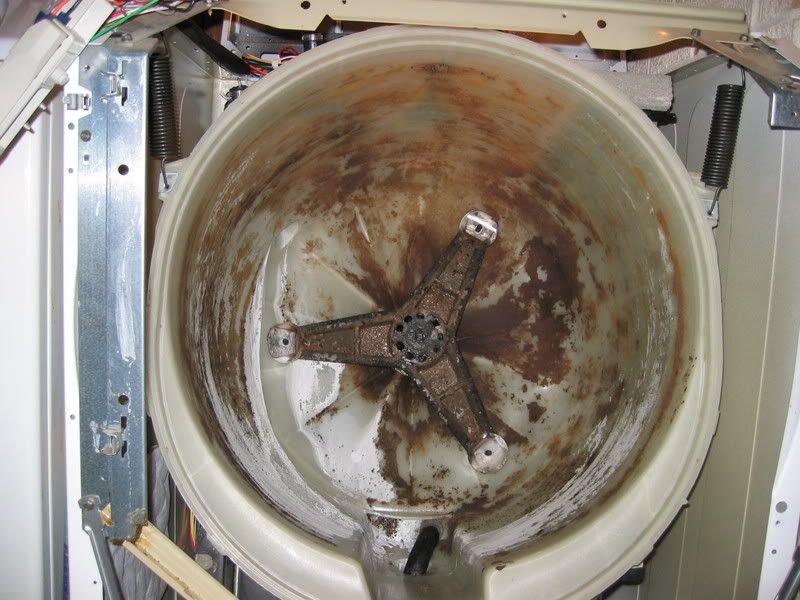mobiledynamics
New member
I`ve been meaning to write this, as with my recent other thread on just emptying a QD bottle, there was ~stuff~ that was hidden from the naked eye.
What spurned this post was I was reading another thread on how fellow members do RWW/WW. I kinda chuckled and said my cajones was not large enough to do either method, just short of Emergency Bird Poop, and asked said users were they pre-rinsing before throwing them into the laundry washer and or just straight in.
This applies to both front loaders and top loaders. Front loaders uses MUCH less water than top loaders but the basic principles apply. BTW, if you have a front loader, keep the front door ajar to let air cycle trough your machine so it can dry.
In your laundry washer, you have a inner drum and a outer drum.
The inner drum is the drum you see - that holds the contents of what you are washing.
The outer drum is the part that envelopes the inner drum that holds the liquids.
It`s important to either launder your clothes/items in Hot Water at Times.
Some washers have sanitize features, and some washers have extra hot water options as well.
Use them if you have them every so often. Said washers may actually have a onboard heater, which is important, to keep the water temp hot throughout the water cycle.
Take some liquid softener and rub it between your fingers.
Try just rinsing your hand clean with just water. (usually liquid softener is dispensed on the final rinse cycle).
Same goes for soap, scum, and body oils...
What is happening is the a BIO FILM of soap, scum, mold , etc - grows inside and lines the inside portion of the outer drum. You won`t see it unless either you peel your gasket back and there is a very small gap between the inner/outer drum, in which you might be able to inspect it by shining a very focused light and looking for it..
This in itself is not a true gauge, as generally there is a lip in the drum, and you can probably only see the 1st couple inches of the drum.
For those doing RW/WW and not prerinsing with something like APC outside separate of the washer , I`d be concerned that between the underlying properties of encapsulating dirt, the affinity of this latching onto your washing machine drum, and the long term or short term effects of this and households not using enough HOT water to really clean your washing machine out...well, you get my point.
I could probably go another 10 more paragraphs on this topic, but hopefully if this was not on your radar, I hope it is now.
What spurned this post was I was reading another thread on how fellow members do RWW/WW. I kinda chuckled and said my cajones was not large enough to do either method, just short of Emergency Bird Poop, and asked said users were they pre-rinsing before throwing them into the laundry washer and or just straight in.
This applies to both front loaders and top loaders. Front loaders uses MUCH less water than top loaders but the basic principles apply. BTW, if you have a front loader, keep the front door ajar to let air cycle trough your machine so it can dry.
In your laundry washer, you have a inner drum and a outer drum.
The inner drum is the drum you see - that holds the contents of what you are washing.
The outer drum is the part that envelopes the inner drum that holds the liquids.
It`s important to either launder your clothes/items in Hot Water at Times.
Some washers have sanitize features, and some washers have extra hot water options as well.
Use them if you have them every so often. Said washers may actually have a onboard heater, which is important, to keep the water temp hot throughout the water cycle.
Take some liquid softener and rub it between your fingers.
Try just rinsing your hand clean with just water. (usually liquid softener is dispensed on the final rinse cycle).
Same goes for soap, scum, and body oils...
What is happening is the a BIO FILM of soap, scum, mold , etc - grows inside and lines the inside portion of the outer drum. You won`t see it unless either you peel your gasket back and there is a very small gap between the inner/outer drum, in which you might be able to inspect it by shining a very focused light and looking for it..
This in itself is not a true gauge, as generally there is a lip in the drum, and you can probably only see the 1st couple inches of the drum.
For those doing RW/WW and not prerinsing with something like APC outside separate of the washer , I`d be concerned that between the underlying properties of encapsulating dirt, the affinity of this latching onto your washing machine drum, and the long term or short term effects of this and households not using enough HOT water to really clean your washing machine out...well, you get my point.
I could probably go another 10 more paragraphs on this topic, but hopefully if this was not on your radar, I hope it is now.



